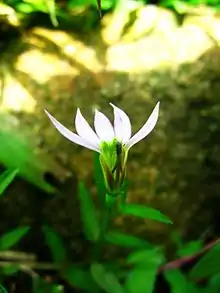Lobelia chinensis
Lobelia chinensis, commonly known as Asian lobelia,[2] Chinese Lobelia, and Herba Lobellae Chinensis, is a species of flowering plant in the family Campanulaceae. It is one of the 50 fundamental herbs used in traditional Chinese medicine, where it has the name (Chinese: 半边莲; pinyin: bàn biān lián).[3]
| Lobelia chinensis | |
|---|---|
 | |
| Flower of Lobelia chinensis | |
| Scientific classification | |
| Kingdom: | Plantae |
| Clade: | Tracheophytes |
| Clade: | Angiosperms |
| Clade: | Eudicots |
| Clade: | Asterids |
| Order: | Asterales |
| Family: | Campanulaceae |
| Genus: | Lobelia |
| Species: | L. chinensis |
| Binomial name | |
| Lobelia chinensis Lour.[1] | |
| Synonyms | |
| |
Description
Lobelia chinensis is a small perennial herb[4] that grows in tangled clumps from 15 centimetres (5.9 in) to 35 centimetres (14 in) long. It has a long, thin, branching stem that is olive green and green-brown crumpled narrow leaves. It has little to no odor and a sweet and pungent taste. When harvesting herbs for medical use, the ones with the greenest stems and yellower roots are preferred.[3]
Herbal medicine
Lobelia chinensis is considered one of the 50 fundamental herbs in Chinese herbology. Historically, L. chinensis has been used in herbal medicine to help stop smoking, however the Food and Drug Administration has banned the use of herbs containing lobeline.
Chemical constituents
Lobelia chinensis contains 6,7-dimethoxycoumarin, fraxinol, 5-hydroxy-7-methoxycoumarin, tomentin, 3'-hydroxygenkwanin, apigenin, quercetin, luteolin, linarin, luteolin 3',4'-dimethylether-7-O-beta-D-glucoside, isoferulic acid, and ethyl rosmarinate.[5]
Toxicity and adverse effects
Lobeliachinensis is considered mildly toxic[1] due to its adverse effects, including vomiting, heartburn, anxiety, vibrating, eclampsia, increased heart-rate, and severe stomach aches.[6]
References
| Wikimedia Commons has media related to Lobelia chinensis. |
- "Lobelia chinensis". Germplasm Resources Information Network (GRIN). Agricultural Research Service (ARS), United States Department of Agriculture (USDA). Retrieved 2008-02-11.
- English Names for Korean Native Plants (PDF). Pocheon: Korea National Arboretum. 2015. p. 524. ISBN 978-89-97450-98-5. Archived from the original (PDF) on 25 May 2017. Retrieved 25 January 2016 – via Korea Forest Service.
- "Lobelia Herb (Ban Bian Lian)". Chinese Herbs Healing. 2008. Missing or empty
|url=(help) - "Lobelia chinensis Lour. - Chinese lobelia". United States Department of Agriculture. Retrieved 22 February 2014.
- Chen JX, Huang SH, Wang Y, Shao M, Ye WC (2010). "Studies on the chemical constituents from Lobelia chinensis". Zhong Yao Cai. 33 (11): 1721–4. PMID 21434431.
- Han J, Zhang F, Li Z, Du G, Qin H (2009). "[Chemical constituents of Lobelia chinensis]". Zhongguo Zhong Yao Za Zhi (in Chinese). 34 (17): 2200–2. PMID 19943485.